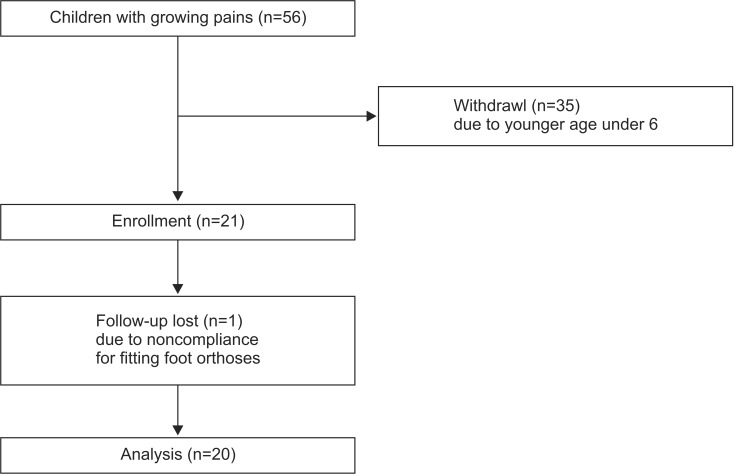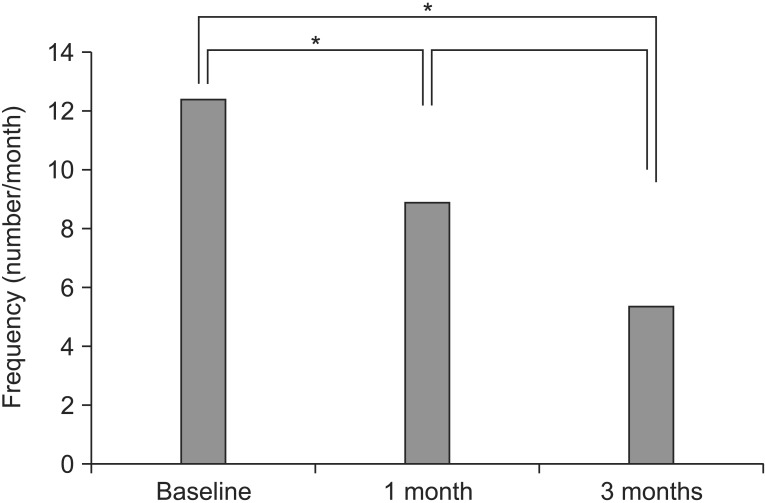Ann Rehabil Med.
2015 Apr;39(2):285-293. 10.5535/arm.2015.39.2.285.
Effect of Foot Orthoses on Children With Lower Extremity Growing Pains
- Affiliations
-
- 1Department of Physical Medicine and Rehabilitation, Inje University Ilsan Paik Hospital, Goyang, Korea. I9534@paik.ac.kr
- 2Institute of Sports Rehabilitation, Inje University Ilsan Paik Hospital, Goyang, Korea.
- KMID: 2273051
- DOI: http://doi.org/10.5535/arm.2015.39.2.285
Abstract
OBJECTIVE
To evaluate the effect of custom molded foot orthoses on children with growing pains of the lower extremities.
METHODS
Children with growing pains were recruited during a clinic visit. None had any bony deformities, inflammatory joint disease or depression. Resting calcaneal stance position (RCSP) and calcaneal pitch angle were measured, and individual custom molded rigid foot orthoses were prescribed using the inverted orthotic technique to control for foot overpronation using the RCSP angle. Pain sites, degree and frequency of pain, and balance ability were evaluated using Balance Master computerized posturography prior to foot orthosis fitting, and 1 and 3 months later.
RESULTS
Twenty children completed the study. Seventeen (75%) had overpronated feet. Significant improvements were noted after 1 and 3 months in pain degree and frequency, and after 3 months in balancing ability.
CONCLUSION
The use of custom molded foot orthoses is a good method for treating children with multiple musculoskeletal pains in the leg.
MeSH Terms
Figure
Cited by 1 articles
-
Effect of Foot Orthoses in Children With Symptomatic Flexible Flatfoot Based on Ultrasonography of the Ankle Invertor and Evertor Muscles
Dong Joon Cho, So Young Ahn, Soo-Kyung Bok
Ann Rehabil Med. 2021;45(6):459-470. doi: 10.5535/arm.21137.
Reference
-
1. Weiser P. Approach to the patient with noninflammatory musculoskeletal pain. Pediatr Clin North Am. 2012; 59:471–492. PMID: 22560580.
Article2. Duchamp M. Maladies de la croissance. Paris: (Fain);1823.3. Uziel Y, Hashkes PJ. Growing pains in children. Harefuah. 2008; 147:809–811. 836PMID: 19039913.
Article4. Lowe RM, Hashkes PJ. Growing pains: a noninflammatory pain syndrome of early childhood. Nat Clin Pract Rheumatol. 2008; 4:542–549. PMID: 18762787.
Article5. Oster J, Nielsen A. Growing pains. A clinical investigation of a school population. Acta Paediatr Scand. 1972; 61:329–334. PMID: 5021456.6. Williams MF. Rheumatic conditions in school-children. Lancet. 1928; 211:720–721.
Article7. Mikkelsson M, Salminen JJ, Kautiainen H. Non-specific musculoskeletal pain in preadolescents: prevalence and 1-year persistence. Pain. 1997; 73:29–35. PMID: 9414054.
Article8. Brenning R. Growing pain. Acta Soc Med Ups. 1960; 65:185–201.9. Naish JM, Apley J. "Growing pains": a clinical study of non-arthritic limb pains in children. Arch Dis Child. 1951; 26:134–140. PMID: 14830278.
Article10. Abu-Arafeh I, Russell G. Recurrent limb pain in schoolchildren. Arch Dis Child. 1996; 74:336–339. PMID: 8669936.
Article11. Oberklaid F, Amos D, Liu C, Jarman F, Sanson A, Prior M. "Growing pains": clinical and behavioral correlates in a community sample. J Dev Behav Pediatr. 1997; 18:102–106. PMID: 9113591.
Article12. Brenning R. "Growing pains". Sven Lakartidn. 1960; 57:85–103. PMID: 13804202.13. Baxter MP, Dulberg C. "Growing pains" in childhood: a proposal for treatment. J Pediatr Orthop. 1988; 8:402–406. PMID: 3292578.14. Friedland O, Hashkes PJ, Jaber L, Cohen HA, Eliakim A, Wolach B, et al. Decreased bone speed of sound in children with growing pains measured by quantitative ultrasound. J Rheumatol. 2005; 32:1354–1357. PMID: 15996077.15. Evans AM, Scutter SD, Lang LM, Dansie BR. "Growing pains" in young children: a study of the profile, experiences and quality of life issues of four to six year old children with recurrent leg pain. Foot (Edinb). 2006; 16:120–124.
Article16. Evans AM. Relationship between "growing pains" and foot posture in children: single-case experimental designs in clinical practice. J Am Podiatr Med Assoc. 2003; 93:111–117. PMID: 12644517.17. Hawksley JC. Growing pains in relation to rheumatism. Br Med J. 1939; 1:155–157. PMID: 20782073.
Article18. Evans AM. Growing pains: contemporary knowledge and recommended practice. J Foot Ankle Res. 2008; 1:4. PMID: 18822152.
Article19. Al-Khattat A, Campbell J. Recurrent limb pain in childhood ('growing pains'). Foot (Edinb). 2000; 10:117–123.
Article22. Blake RL. Inverted functional orthosis. J Am Podiatr Med Assoc. 1986; 76:275–276. PMID: 3712254.
Article23. Evans AM, Scutter SD. Are foot posture and functional health different in children with growing pains? Pediatr Int. 2007; 49:991–996. PMID: 18045309.
Article24. Brukner P, Khan K. Brukner & Khan's clinical sports medicine. 4th ed. New York: McGraw Hill;2012.
- Full Text Links
- Actions
-
Cited
- CITED
-
- Close
- Share
- Similar articles
-
- Orthotic and Prosthetic Options after Diabetic Foot Amputation
- Effect of Custom-Molded Foot Orthoses on Foot Pain and Balance in Children With Symptomatic Flexible Flat Feet
- Long Term Effect of Custom-Molded Foot Orthoses on Foot Pain and Balance in Children with Symptomatic Flexible Flat Feet
- Effect of Ankle Foot Orthosis on Hemiplegic Gait
- Study on the Correlation Between Hyperextension of the knee Joints and Growing Pain





